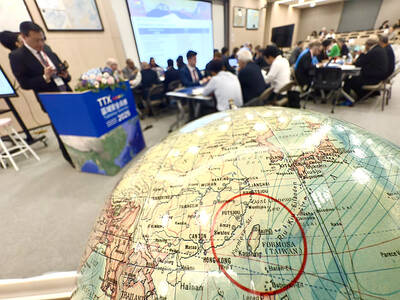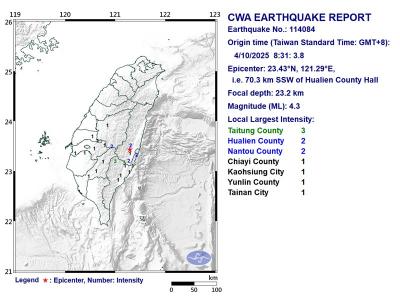The nation has taken a successful step in tracking the migration route of the gray-faced buzzard eagle, or Butastur indicus, paving the way for better conservation measures for the rare migratory bird, a Forestry Bureau official said.
Conservation Division Director Kuan Li-hao (管立豪) said scientists put satellite transmitters on three gray-faced buzzard eagles as they passed through Taiwan this fall. After being released on Oct. 12 in Kenting (墾丁), the birds reached the Philippines the next day.
Kuan said it was the first time that the migratory movements of the species had been recorded anywhere in the world.

PHOTO: CNA
Two of the three birds, nicknamed Cape No. 2 and Cape No. 3, are on Luzon Island, while Cape No. 1 headed further south in the Philippines, Kuan said.
The satellite transmitters on the birds send signals to the research group, which will continue to record the birds’ movements next spring during their migration northward.
Because of budget limitations, the research group could only implant transmitters on three birds.
“But thanks to the research, Taiwan may have the opportunity to cooperate with countries in Southeast Asia, such as the Philippines, to enhance conservation” of this rare species, Kuan said.
The buzzard eagle is listed as protected in the Convention on International Trade in Endangered Species of Wildlife Fauna and Flora.
Normally, 15,000 to 35,000 of the birds pass over Taiwan every year in the spring and autumn, the Forestry Bureau said. This year, however, an estimated 42,000 gray-faced buzzard eagles had crossed over Taiwan by the end of last month — the highest number since the bureau began counting the migration in 1989.
Kuan attributed the higher numbers on the weather, which was relatively stable between Oct. 8 and Oct. 20 compared with previous years.
He said forest district offices had also worked to prevent hunters from killing the birds.

DEFENSE: The National Security Bureau promised to expand communication and intelligence cooperation with global partners and enhance its strategic analytical skills China has not only increased military exercises and “gray zone” tactics against Taiwan this year, but also continues to recruit military personnel for espionage, the National Security Bureau (NSB) said yesterday in a report to the Legislative Yuan. The bureau submitted the report ahead of NSB Director-General Tsai Ming-yen’s (蔡明彥) appearance before the Foreign and National Defense Committee today. Last year, the Chinese People’s Liberation Army (PLA) conducted “Joint Sword-2024A and B” military exercises targeting Taiwan and carried out 40 combat readiness patrols, the bureau said. In addition, Chinese military aircraft entered Taiwan’s airspace 3,070 times last year, up about

The Overseas Community Affairs Council (OCAC) yesterday announced a fundraising campaign to support survivors of the magnitude 7.7 earthquake that struck Myanmar on March 28, with two prayer events scheduled in Taipei and Taichung later this week. “While initial rescue operations have concluded [in Myanmar], many survivors are now facing increasingly difficult living conditions,” OCAC Minister Hsu Chia-ching (徐佳青) told a news conference in Taipei. The fundraising campaign, which runs through May 31, is focused on supporting the reconstruction of damaged overseas compatriot schools, assisting students from Myanmar in Taiwan, and providing essential items, such as drinking water, food and medical supplies,

STRICTER ENFORCEMENT: Taipei authorities warned against drunk cycling after a sharp rise in riding under the influence, urging greater public awareness of its illegality Taipei authorities have issued a public warning urging people not to ride bicycles after consuming alcohol, following a sharp rise in riding under the influence (DUI) cases involving bicycles. Five hundred and seven people were charged with DUI last year while riding YouBikes, personal bicycles, or other self-propelled two-wheelers — a fourfold increase from the previous year, data released by the Taipei Police Department’s Traffic Division showed. Of these, 33 cases were considered severe enough to be prosecuted under “offenses against public safety,” the data showed. Under the Road Traffic Management and Penalty Act (道路交通管理處罰條例), bicycles — including YouBikes and other

A magnitude 4.3 earthquake struck eastern Taiwan's Hualien County at 8:31am today, according to the Central Weather Administration (CWA). The epicenter of the temblor was located in Hualien County, about 70.3 kilometers south southwest of Hualien County Hall, at a depth of 23.2km, according to the administration. There were no immediate reports of damage resulting from the quake. The earthquake's intensity, which gauges the actual effect of a temblor, was highest in Taitung County, where it measured 3 on Taiwan's 7-tier intensity scale. The quake also measured an intensity of 2 in Hualien and Nantou counties, the CWA said.